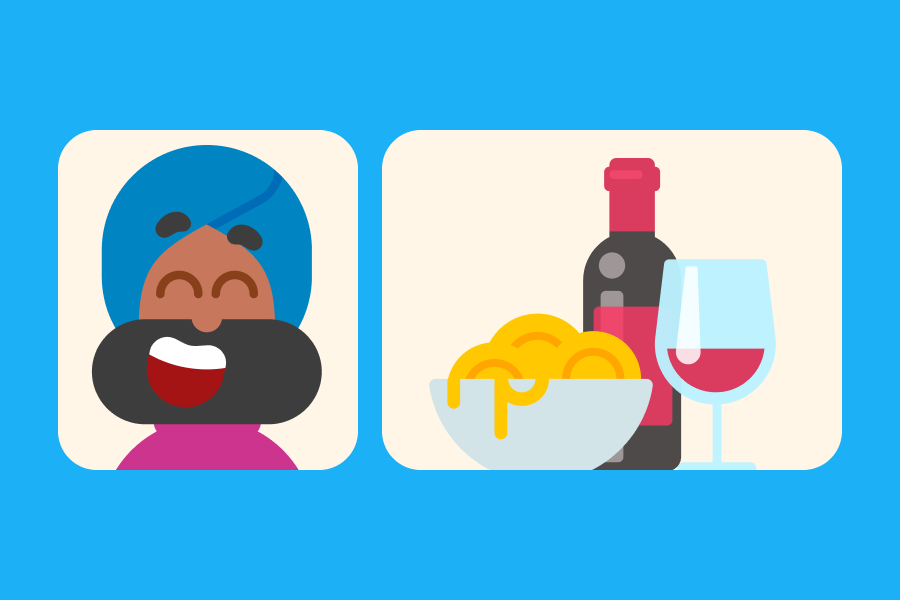Who doesn’t love Italian food? If you’re traveling to Italy, you’ll definitely want to make the most of the opportunity to sample the local cuisine. Familiarizing yourself with some basic vocabulary and Italian food customs is a great way to make sure you order exactly what you want and have the best possible experience. Here's everything you need to know to have a delicious meal in Italy!
Where to eat in Italy
You probably already know what a pizzeria is and have no trouble figuring out that a ristorante is a restaurant, but you'll want to try out some other great options!
Breakfast
For breakfast, you’ll most likely make your way to a bar. Don’t be confused by the name: This is actually a café, although some bars may also serve alcohol later in the day.
Lunch
For lunch, you might want to try a panineria, which is a place that serves panini (sandwiches), or a rosticceria, where you can get a variety of quick, hot dishes. Or, if you’re not too hungry, you can head back to the bar for tramezzini, which are light finger sandwiches that are smaller than what you’d get at a panineria.
Dinner
For dinner, a ristorante is the fanciest option, but if you’d like to dine somewhere a little less formal, you can also eat at an osteria or a trattoria. And if you’re ever in the mood for a sweet treat, you’ll want to head to a gelateria for gelato (ice cream) or a pasticceria for pastries!
How to order food in Italy
When visiting a sit-down restaurant, you’ll likely need to tell the cameriere (server) how many people are in your party before getting a seat:
- If you’re by yourself, you’ll ask for Un tavolo per uno(A table for 1).
- For two people, Un tavolo per due(A table for 2).
- For three people, Un tavolo per tre(A table for 3).
- For four people, Un tavolo per quattro(A table for 4).
You might also consider making una prenotazione (a reservation) online on the restaurant's website, especially if you have your heart set on a particular ristorante.
A little language goes a long way, so here are some other common phrases you’ll want to know:
- Salve(hello)
- Scusi(excuse me)
- Per favore(please)
- Grazie(thank you),grazie mille(thank you very much)
- Prego(you're welcome)

What you'll find on the menu
Once you’re seated, you'll see that lunch and dinner are divided into courses, but you don't have to order something from every course. Depending on the restaurant, you’ll either order something off the menu for each course, or you’ll choose from a “fixed price” menu. Fixed menus will give you the option of a few different courses, and you'll choose from a smaller set of options.
Here's what you can expect from a typical menu:
| What's on the menu | How to order |
|---|---|
| Antipasti (appetizers) |
Come antipasto, vorrei... (As an appetizer, I'd like...) |
| Primi (first courses) |
Come primo, vorrei... (For the first course, I'd like...) |
| Secondi (second courses) |
Come secondo, vorrei... (For the second course, I'd like...) |
| Contorni (side dishes) |
Come contorno, vorrei... (As a side dish, I'd like...) |
| Dolci (desserts) |
Come dolce, vorrei... (For dessert, I'd like...) |
| Bevande (drinks) |
Da bere, vorrei... (To drink, I'd like...) |
When you’re done eating, you’ll have to ask for the check—it will not automatically be brought to you. To do this, you can say Il conto, per favore (The check, please). You may see either a coperto or a servizio listed on the bill and included in the final price. The coperto is a cover charge for things like bread and cutlery, and the servizio is similar to a tip for the staff. Beyond these required charges, it’s not obligatory to tip in Italy, and if you do want to, rounding the bill up, leaving a few coins, or leaving 1€ per person is standard—it depends a bit on the region and city!
At the bar... for breakfast!
For colazione (breakfast) in Italy, you’ll typically order coffee and a pastry from the local bar. Sitting down at a table will cost more than if you eat and drink while standing at the bar. Since Italian coffees are generally much smaller than in English-speaking countries anyway, this can be a great way to save money to use elsewhere on your trip! If you do stand at the bar, some cafes require that you pay a cashier for your order first before asking the barista to serve you.
When it comes to what to order for colazione, you’ll have lots of options! For pastries, the most common choice is a croissant, which is usually called a brioche if you’re in northern Italy or a cornetto if you’re in the south. In southern Italy, you’ll also see brioche on the menu, but this is more likely to refer to a type of sweet roll. If you’re in Sicily, you’ll also want to try granita, which is a smoother version of crushed ice that comes in many flavors, like limone (lemon), mandorla (almond), or pistacchio (pistachio).
There are many coffee choices in Italy too, and a few can be confusing for English speakers. You might not see espresso on the menu, because this is the default coffee in Italy! Instead you'll see it called caffè or caffè normale. And ordering a latte will get you a plain glass of milk!
What should you ask for instead? Here are some of the most common options:
- Caffè ristretto/Caffè basso/Caffè corto: a more concentrated espresso
- Caffè lungo: a less concentrated espresso
- Caffè americano: espresso with a lot of water added
- Caffè macchiato: espresso with a little bit of milk
- Cappuccino: equal parts espresso, steamed milk, and foam
- Caffellatte: a mixture of espresso and milk, without foam, sometimes served in a glass
- Latte macchiato: steamed or foamed milk with a little bit of espresso, sometimes served in a glass
- Caffè freddo: chilled espresso
- Shakerato: hot espresso shaken with ice
- Caffè corretto: espresso with liquor
- Caffè d’orzo: a caffeine-free coffee alternative made with barley
- Ginseng: a caffeine-free beverage made with ginseng
You'll also find that Italians don't order a cappuccino with food after the usual breakfast hours. They might have one on its own later in the day, but ordering a cappuccino with lunch or dinner will raise some eyebrows!
At the pizzeria
Many common combinations of pizza toppings have particular names in Italy, which may be confusing if you’re not sure what they refer to. This list includes some common choices:
- Capricciosa: tomato sauce, mozzarella, ham, hard-boiled egg, mushrooms, olives, and sometimes artichokes
- Diavola: tomato sauce, mozzarella, pepperoni, and spicy peppers
- Marinara: tomato sauce, garlic, and oregano
- Margherita: tomato sauce, mozzarella, and basil
- Napoli: tomato sauce, anchovies, and capers
- Norma: tomato sauce, fried eggplant, ricotta salata cheese, and oregano
- Parmigiana: tomato sauce, mozzarella, eggplant, Grana Padano cheese, and basil
- Quattro formaggi: four cheeses (with or without tomato sauce)
- Quattro stagioni: tomato sauce, mozzarella, ham, artichokes, mushrooms, olives, and basil
- Vegetariana: tomato sauce, mozzarella, and vegetables (different in each pizzeria)
You can also ask for particular ingredients on your pizza, but one thing you should keep in mind as an English speaker is that peperoni means peppers, not meat! If you want pepperoni on your pizza, you should ask for salame. Some other common ingredients you might want to ask for are prosciutto (ham), salsiccia (sausage), and funghi (mushrooms). If you’re adventurous, you can also try pizza with frutti di mare (seafood)!
At the gelateria
Like at the bar, you’ll want to pay for your order at a gelateria before asking for what you want. You’ll ask for una coppetta (a cup) or un cono (a cone), and you can choose more than one flavor. There will be lots of choices, so if you want to try before you buy, ask Posso provare… (Can I try…) to see if you like a particular flavor. Here are some of the most common:
- Amarena: sour cherry
- Bacio: chocolate with hazelnut (bacio is literally "kiss"!)
- Caffè: coffee
- Cioccolato: chocolate
- Cocco: coconut
- Fior di latte: sweet cream
- Fragola: strawberry
- Limone: lemon
- Nocciola: hazelnut
- Pesca: peach
- Pistacchio: pistachio
- Stracciatella: vanilla with chocolate chips
- Torrone: nougat
- Vaniglia: vanilla
- Zabaione: custard with Marsala wine
- Zuppa inglese: custard with cookies or cake, and often liqueur (zuppa inglese means "English soup"!)
Buon appetito!
In Italy, the dining options are abundant, so you shouldn’t feel limited even if you only speak a few words of Italian! Just refer back to this guide for tips, use whatever Italian words you can, be polite and friendly to the staff you encounter, and you’re sure to enjoy your meal 🍽
